Charan Singh Interlude
by Sachi Sri Kantha, February 18, 2025

Arul M. Pandian
As this series had reached Part 80, it’s my onus to express my gratitude and thanks to Arul M. Pandian (originally from Madurai, now in USA), a pal of more than 20 years, for his continuous encouragement of this series by posting his reflections in the Readers’ Comments section. Furthermore, other than R. Kannan, I was also a beneficiary of Arul’s kind-hearted gifts of numerous Tamil books on notable personalities. Arul also helps me to verify Tamil slang use in Tamil Nadu as well.
About the contents in Part 79 specifically, I received the thoughts R. Kannan on Jan 17. These were as follows:
“I read part 79 with great interest and was again pleased with how well you have pulled together the various strands for this essay. Kudos. MGR’s Kalki interview, which I had missed, does display MGR’s administrative acumen…. Of course thank you for the BBC interview. Indira Gandhi was an articulate woman especially during interviews.
Karunanidhi did not practice antagonistic politics from 1969-76. The initial years were cordial until at least MGR’s exit. Karunanidhi rightly suspected a Congress I hand as Mohan Kumaramangalam, mainly viewed Karunanidhi’s rise with alarm. Soon thereafter, Karunanidhi upped his ante on the demand for state autonomy. After Kumaramangalam’s demise, this demand took an even shriller pitch, culminating in the 1974 assembly resolution. Indira Gandhi was now tired of him. The emergency saw him blow hot and cold. The rest is history. MGR had considerably been chastened by the lessons from Karunanidhi’s confrontational politics. He saw to it that he did not antagonise the Centre.”
My response to Kannan’s thoughts was as follows:
“Thanks a lot for your thoughts on Part 79. I do agree with all your comments. Yes, you were correct that Karunanidhi’s initial years with Indira (1969-71) were cordial. Probably, for the reason that he didn’t have his own mandate from the TN voters. And also to guard against Kamarajar who was still alive. Once, Karunanidhi gained his own mandate in 1971 (and also beating Kamarajar’s Old Congress convincingly), his moves changed.
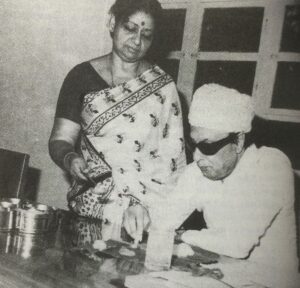
MGR having a meal at home, served by wife V.N. Janaki
You are also correct that Indira was articulate and convincing in her answers, when she faced tough questions in UK. I’m sure none of the Indian journalists wouldn’t have such a courage to ask such questions in India. This is also the difference between Indira and Sirimavo Bandaranaike. Sirimavo’s fluency in English was not on par with that of Indira, because she was a housewife, and pushed into politics only after her husband’s assassination. But, Indira was trained from her adolescent days to talk with the bigwigs of pre-Independent India.”
Passing of Same Age cohorts in the Tamil Cinema
The death of M.R. Radha, was noted in the last chapter. He was MGR’s senior contemporary by 10 years. In addition, those belonging to the same age cohort of MGR in the Tamil cinema and who were close to him were also bidding adieu, one by one. On September 8, 1978, MGR’s closest pal in the industry Sandow M.M..Chinnappa Thevar had died at the age of 63. He was the only one to produce 16 of MGR’s movies, from 1956 to 1972. Two more movie personalities close to MGR also died in 1979. One was MGR’s most favorite music director S.M. Subbiah Naidu (b. 1914); He died on May 26th at the age of 65. The second one was Gopichettipalayam Nagappan (G.N.) Velumani (b. 1918), who had died on August 24th at the age of 60. Velumani was the producer of five of MGR’s hit movies in 1960s – Panathottam, Padahotti, Kalangarai Vilakkam, Chandrothayam and Kudiyiruntha Kovil.
In his autobiography, MGR had described the trusting relationship he enjoyed with all three of these pals. Among the 14 movies, which ‘turned’ his prolific career in films, MGR had identified one each produced by Chinnappa Thevar (Thai Sollai Thattathe, 1961) and Velumani (Kudiyiruntha Kovil, 1968) as his memorable ones. A signature item in almost all MGR movies was a well-tuned, solo song for him. Subbiah Naidu set this trend in the first movie, MGR starred as a hero in Rajakumari (The Princess, 1947). The Youtube clip of this old song, sung by M.M. Mariappa, while young MGR was walking bare-footed, is available in this link.
https://www.youtube.com/watch?v=shP8gfBUO8Q
Also, among the 14 of his successful movies, Subbiah Naidu was the tunesmith for the five – Rajakumari (1947), Marma Yogi (1951), Malai Kallan (1954), Nadodi Mannan (1958) and Thirudathe (1961). MGR was so effusive in his praise of Subbiah Naidu and deep-felt gratitude to him. Thus, it may also be surmised that MGR himself might have felt that he was also nearing the target range of Grim Reaper.
Kalki magazine editorial of Aug 12, 1979
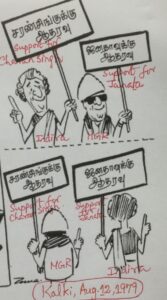
Kalki cartoon 1 – Aug 12, 1979
In its Aug 12, 1979, Kalki magazine published an editorial, with a caption ‘One for Truth’. Translated excerpts follow
“It appeared that the Charan Singh Cabinet would topple at the beginning itself. Now, it had stabilized a little…Those who supported Indira [Gandhi] during her Emergency period are now placed in the Cabinet. This choice of Chaudary ji’s [Charan Singh] has to be described as pathetic rather than a comedy. Those Congress folks who opted to support the new government could have told ‘why not appoint a few of our party’s youngsters We will be in the side to give advice.’ In case if the Cabinet falls tomorrow, they could have retained their honor. But, these geezers were teased b the positions. All became Ministers.
Indira Gandhi is acting ‘double role’. ‘If she plays double role, I can tackle quadruple roles’, says MGR. One cannot comprehend, whom he supports when and where…”
Yes, for his support for sustaining Charan Singh Cabinet, MGR was offered two Cabinet portfolios. And he designated two from his party. One was Mrs. Sathyavani Muthu (1923-1999). The second one was Aravinda Bala Pajanor (1935-2013), the then leader of the ADMK MPs group in Lok Sabha. MGR’s choice for these Cabinet positions were rather unconventional. Sathyavani Muthu, at the age of 56, was a founder member of DMK and was one of the 15 (and only woman) to get elected to the Madras Legislative Assembly in 1957. She represented the Oppressed Communities. Bala Pajanor, aged 44, from Pondicherry (now Puducherry) was a new face, and a Christian. More about these two, towards the end of this chapter.
MGR’s balancing act between choosing Morarji Desai and Charan Singh during 1979 was depicted in two period cartoons (1 and 2) that appeared in the Kalki weekly in Aug 12 and Oct 28. These are presented nearby. Cartoon 1 shows that, when Indira was supporting Charan Singh, MGR was attached to Janata Party. Subsequently, when MGR was attached to Charan Singh, Indira deflected her ‘support to Janata Party’. Cartoon 2 shows that Charan Singh was gripping MGR’s right hand with force, while MGR’s left hand barely holds to Morarji’s one finger.
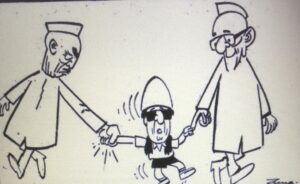
Kalki cartoon 2 – Oct 28, 1979
Morarji Desai’s interview to India Today magazine, August 1979
An interview given by Morarji Desai, after his resignation of the Prime Minister job, appeared in the India Today issue of Aug 31, 1979. Selected excerpts are given below.
“Interviewer (Q) How do you feel being out of the premiership now?
Morarji Desai (A): I ever inconvenienced? I never feel any different. Here, there, everywhere. I have no different feeling at all. Whether you sit on a sofa or a chair, does it make any difference? It does to some people. But to me, it makes none.
If it makes no difference, why did you delay in resigning from the presidentship of the Janata Parliamentary Party (JPP) after you resigned as premier?
A Why should I have to resign as leader? There was no vote of censure on the leader. Vote of censure was on the Government. It is your ‘bee in the bonnet’ which makes you say that I should have resigned. Why?
But eventually you did resign.
A. I resigned for other reasons. I would not have resigned but for the mistake in that letter.
Mistake in which letter?
A. The letter which I sent to the President with the names.
How did that mistake come about?
A. Well, I don’t think it was deliberate. But it was not verified by me. I couldn’t do that because I didn’t get time. Now, I have to atone for my mistake, because the ultimate responsibility is mine.
So, if that had not happened you would have continued to be president of JPP?
A. I was not going to resign. If they wanted to remove me they only could do so by a two-third vote. Then, I would have resigned indeed. Is it my fault that all this has happened?
What do you think broke your government?
A. Why do I have to say that? Has not Charan Singh just said? He was so imprudent as to say that, “I have fulfilled the ambition of my life.” What does that mean?
Few days before you resigned as PM, you had made a statement that you would win the vote of confidence by a majority of over 100. What was that statement based on?
A. There were many people from the Opposition who told me that they were not going to vote. They didn’t want to vote. That’s what they told me.
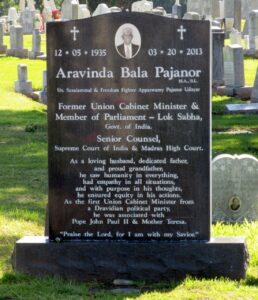
Tombstone of Aravinda Bala Pajanor (1935-2013)
How did things change in a few days?
A. Because certain people resigned from my government and ultimately Jagjivan Ram said that he would resign too. Then they thought it was better for me to resign now than after the defeat. We knew we were going to lose.
If there is a mid-term poll would you stand for elections?
A.I don’t think so. Why did I resign?
There is a general belief that the President has not been fair to you and has not treated you properly. Do you feel he has been unfair to you?
A. Me? Personally there is nothing. Whatever I do is not for my person. You judge for yourself. Why do you ask me? It is an extraordinary manner in which he has functioned. That is all I can say. Can two people be called at the same time to form a government? Can anybody be called to form a government without a majority? And it is obvious from the letter that it is not so.
What could have been the motivation for his actions?
A. How can I go into the motivations of anybody? I don’t like to attribute motives to anybody.
Do you feel that the President double-crossed you?
A. I had asked one more day from the President. He had first agreed. But after that he changed his mind and said it would have to be before 4 o’clock the same day. So I didn’t want to get into a quarrel about it. Why should I? For example, when I was going to speak on the AIR [All India Radio]| he phoned me and asked: “What are you doing? This is not right.” I said: “How is it not right?” “You are a caretaker government,” he said. What is a caretaker government? There is no word like caretaker in the Constitution – a government is a government. I was not doing anything else. I was only giving reasons for my resignation.
But why didn’t you protest against it?
A. I did tell him. If I had a majority at that time I would have shown him his place. But then he would not have dared to say that. Anyway at that stage, I couldn’t do anything. I don’t believe in impotent efforts.
It is said that you have a blind spot for the weaknesses of your son?
A. I have a blind spot for nobody. I am a completely non-aligned person. I can say this without any dislike or disfavour. But because he is my son I do not want to harm him and do him injustice in order to save myself. That will be wrong.
There are reports that Kantibhai is getting into active politics. Is that true?
A. I don’t know. Ask him. He is 53
Why couldn’t your government take effective action against Mrs Gandhi?
A. We had taken whatever action we could take – we didn’t want to be vindictive. We proceeded according to law and in law you have to make inquiries. These things cannot be done immediately. That is why the Commission was appointed. When the Commission reported, we took up those cases.
How do you regard her politically?
A. What have I to regard?
Now that she holds the fate of the present government in her hands?
A. How?
Without her support, the (Charan Singh) Government can fall.
A. Even with her support there will be nothing. Such support is no support – anybody who depends on support, I think poorly of him. That’s all that I can say. I have no dislike for her.
You have no dislike for her?
A. I have no dislike for any person on this earth – why should I dislike anyone? I dislike some deeds – that’s all. No person is wholly bad or wholly good – a person is always a mixture – more or less.
The President at that time was Neelam Sanjiva Reddy (1913-1996).
Indira’s Hands and Sanjeeva Reddy’s Heart
How Indira Gandhi and President Sanjeeva Reddy played their hands in pushing Morarji Desai and Charan Singh, from their pedestals is recognizable from two editorials in Economic and Political Weekly. Excerpts are given below.
Editorial of Aug 18, 1979 – ‘Buying Time’
“…Indira Gandhi has not merely been politically rehabilitated; she is once again turning out to be the crucial element around whom the whole political process is revolving.
It seems unlikely, however, that at this stage Indira Gandhi would actually help in toppling the Charan Singh government. Her long-term plans no doubt include her own prospective return to power…Above all, she has everything to gain by continuing to practice brinkmanship vis-à-vis the Charan Singh government, constantly keeping it in suspense, and in the meanwhile allowing it to discredit itself further.
In this context, there have been some reports about the alleged displeasure of Indira Gandhi over the fact that Charan Singh has not merely included persons like Pai, Subramaniam and Karan Singh – who have all at one time or the other spoken against her since 1977 – in the Union Cabinet, but has also given no indication that the Special Courts would be scrapped. Indeed, it was widely believed that the abolition of the Special Courts was the prime demand that Charan Singh had to meet before any support from the Congress (I) was forthcoming. But such thinking takes little account of the political sophistication of Indira Gandhi. It is true that she has reason to fear the Special Courts and their outcome, provided that they are allowed to function normally.…
Indira Gandhi was the first Prime Minister to be voted out of office, but at the end of her term (if one overlooks the fraudulent extension of the Fifth Lok Sabha); Morarji Desai was the first to be voted out of office in the midst of his term, and by a process of defections; and Charan Singh cannot possibly reverse the trend.
One of the features of last month’s political crisis was the extraordinarily active role played by the President. There is little doubt that the President thoroughly relished his role, as also the discomfiture of many ‘politicians’….”
The Subramaniam mentioned above in the editorial was the veteran Congress Party leader from Tamil Nadu, Chidambaram Subramaniam (1910-2000) who had served in Indira’s Cabinet as the Minister of Finance, even during the Emergency Period of 1975-76. Subsequently, he left her and joined the breakaway Congress led by Devraj Urs, and was nominated for the Minister of Defense position by Charan Singh in 1979.
Editorial of August 25, 1979 –‘ The Fourth Actor’
“The legality and constitutionality of President Sanjiva Reddy’s decision to dissolve the Lok Sabha and order fresh elections will continue to be debated for long. Given the nature of the issues involved – and with constitutional experts as ready to defend the President’s action as to condemn it – the controversy over the President’s action can never be resolved…
On the face of it, it is difficult not to sympathise with the predicament of Sanjiva Reddy. After the comeuppance dished out to Charan Singh by Indira Gandhi so soon after helping him to overthrow the Morarji Desai government, any assurances of support on her part to other aspirants for prime ministership could not have been taken into account in assessing the capacity of different combinations to ensure a stable administration…
There has also been a curious reversal of roles; unlike Indira Gandhi in 1969 who, in fighting Sanjiva Reddy has been in the present instance in search of a weak Prime Minister the better to be able to control him. None filled the bill better than Charan Singh; and hence the invitation to Charan Singh, as well as the decision to allow him to continue in office even though he has not fulfilled the ‘condition’ set out by the President himself in his initial letter of invitation….But if the events of the last few weeks have any meaning at all, it is that there is a fourth actor in the political drama in Delhi – President Sanjiva Reddy himself…”
Karunanidhi’s version
Though somewhat biased against MGR and his party, as I had pointed out earlier, Karunanidhi’s autobiography is a valuable record of notable events. As such, I provide excerpts from this source as well.
“On July 28, 1979, Charan Singh (as prime minister), Y.B. Chavan (as deputy prime minister) and 7 ministers assumed their duties… Though ADMK had announced that they will support Morarji Desai externally, Charan Singh announced that he will offer Central Cabinet Minister position(s) to ADMK…On July 30, 1979, 17 Ministers including C. Subramaniam assumed duties. At the ADMK parliamentarians meeting held under MGR’s leadership on Aug.1, 1979 at Chennai, it was decided to join the Central government Cabinet. In a meeting held at Aug 8, 1979 with the reporters, Chief Minister MGR announced that ADMK will support the motion of confidence on Charan Singh government, and if Charan Singh Cabinet needs ‘confidence’, the votes of 18 ADMK MPs will work towards this aim. Then, on Aug 19, 1979, on the recommendation of MGR, two ADMK leaders Mrs Satyavani Muthu and Bala Pajanor joined the Central government Cabinet. This happened on Aug 19, 1979. The very next day on 20th, what happened?
Charan Singh met the President on Aug 20th morning and informed the resignation of his government and recommended holding an interim general election…Thus, Charan Singh gained a reputation of the prime minister who failed to test his strength at the parliament, and the two ADMK Cabinet ministers ‘lost their functional status within a day’. On August 22, 1979, the President dissolved the parliament and requested to Charan Singh to continue as a care-taker prime minister until interim Parliament elections were held in Nov-Dec. (1979).”
Karunanidhi’s recording of events continues,
“…Tamil Nadu Chief Minister MGR was in Delhi on Sept. 6 [1979]. That evening he was to meet Indira Gandhi. But this meeting was abandoned. The reason as expressed by [Indian] Express daily was, confusion of MGR. The background story was that day morning, MGR had met prime minister Charan Singh. The latter had told MGR ‘If ADMK will maintain links to Indira Congress, it is reasonable that the ministers in his Caretaker government should leave the Cabinet.’ Because of this, MGR had returned without meeting Indira Gandhi….
Subsequently, (C.M.) Stephen (a confidant of Indira Gandhi, who was a Cabinet minister in Indira’s government) had contacted (Murasoli) Maran to initiate an electoral understanding between Indira Congress and DMK, for the good of India and to offer a stable government at the Center. This was passed to me by Maran…
I met Indira Gandhi in Delhi on Sept 15, 1979, after a 4 year gap. I was accompanied by Tennarasu and Arcot Veerasamy. At Indira’s house, I was welcomed by Tamil Nadu Congress Party leaders R.V. Swaminathan, R. Venkataraman as well as C.M. Stephen and Indira. We two, spoke for nearly an hour….
MGR went to Delhi and met Prime Minister Charan Singh on Sept 28, 1979. Indira Gandhi visited Chennai on Sept 30, 1979 and took part in a celebratory joint meeting held by DMK and Indira Congress. To the questions asked by reporters, Indira responded as follows;
Question: It is being talked that at the last minute, there may be an alliance between ADMK and Indira Congress?
Indira Gandhi: (in anger) We are not ADMK, to change decisions as often. Now, we have an alliance with DMK. This alliance is a firm one. We will not break the trust people have on us. In the past, we had functioned jointly. As such, there is no problem of distaste among us.
Question: MGR had been your friend. He supported your Emergency declaration. Now, why you had broken this friendship?
Indira Gandhi: He might have been my friend. But he is very scared of Janata. MGR couldn’t be trusted. This was well known during the Thanjavur by-election. As such, one cannot offend politics because of friendship. How can Indira Congress have alliance with one who has relationship with Janata and Charan Sing’s party.
Question: How will you comment about the Sarkaria Commission to investigate DMK?
Indira Gandhi: I was forced by Communist Party of India and ADMK. Because of this Sarkaria Commission was induced. But, compared to the corruption charges after Janata leaders came to power, the corruption charges on Karunanidhi were nothing.”
Few points to note in the details presented by Karunanidhi above were: (1) Karunanidhi had chosen to present only three questions from the reporters, which appeared favorable to his stance, and ignored the rest of the questions. (2) Considering the totality of the questions asked by the reporters at that time, these three questions could well be out of context. (3) Considering the time lag between the deposition of complaints by MGR and the Communist Party leader M. Kalyanasundaram in late 1972 and the constitution of the Justice Ranjit Singh Sarkaria Commission in Feb 1976 following the dismissal of Karunanidhi’s DMK government on January 1976, Indira’s answer to deflect the appointment of this Commission as ‘I was forced by the Communist Party of India and ADMK’ is in variance with other political decisions she had made in her career. (4) Indira also had ignored the fact that she also gave a letter of conditional support to install Charan Singh as the prime minister, to replace Morarji Desai, only to pull Charan Singh’s leg at the last minute. By the political standards of India, this deed of Indira had to be considered as a vindictive act of ‘tit for tat’.
A short commentary in the Economic and Political Weekly also indicated doubts on Indira’s version of truth. To quote, “Indira Gandhi has been quite unfair to herself. In a chat with newsmen in Madras on September 30, Indira Gandhi is reported to have said that she was ‘pressurised’ by the AIADMK and the CPI to appoint the Sarkaria Commission to probe into the corruption charges against the Karunanidhi and some of his colleagues – a most surprising ‘confession’ to have come from one who has always prided herself on never allowing herself to be ‘pressurised’. For one who has consistently tried to project the image of a ‘strong’ government, such a confession of pliability is, to say the least, self-denigrating. Moreoever, it does not even have the virtue of being true.”
Mrs. Sathyavani Muthu (1923-1999) story
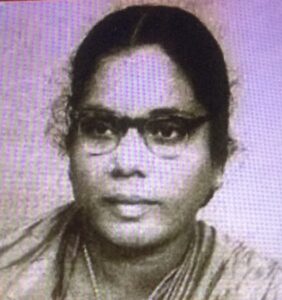
Mrs Sathyavani Muthu (1923-1999)
Mrs. Sathyavani Muthu was the first woman minister from Tamil Nadu who served in the Central government Cabinet of India as Minister of Social Welfare, for only four months duration in 1979. There is an interesting 24 minute video of her life (presented by Kalaignar TV news). The link is as follows
https://www.youtube.com/watch?v=Udvqk4Pnjxs
In this video, her three children (Chitramugi, Maragathamani and Chezhian) speak about the struggles faced by their mother. What is noticeable (and despicable!) was that MGR’s name doesn’t come out from their mouth, or from that of the woman commentator Gouthami. Though belonging to the depressed community among Tamils, Sathyavani Muthu was nominated for the Central government Cabinet position, by MGR in 1979, thus recognizing her services for the Dravidian politics, since 1944.
Citing differences from Karunanidhi-led DMK, Sathyavani Muthu quit DMK in 1974 and formed a short-lived breakaway party called Thazthapattor Munnetra Kazhagam (loosely translated as, Progressive Federation of the Oppressed). Subsequently, she merged this party with MGR’s ADMK in 1977. She stood as an ADMK nominee to the Ulundurpet constituency in the 1977 Legislative Elections, but lost to the DMK candidate by a margin of 7,577 votes.
In this regard, a comparison between MGR and Karunanidhi’s nominations for the Central government Cabinet Minister is rather interesting. Since 1989, DMK had representatives in the Central government Cabinet of India. Karunanidhi’s choice nominees were mostly his family members – nephew Murasoli Maran (1934-2003), nephew’s son Dayanidhi Maran (b. 1966) and second son M.K. Alagiri (b. 1951)!
On Aravinda Bala Pajanor (1935-2013)
Aravinda Bala Pajanor, an attorney at law, was chosen by MGR to the Central government’s Cabinet position in July 1979. At age 44, he was the youngest Minister in the Charan Singh Cabinet, and was assigned the Ministry of Petroleum, Chemicals and Fertilizers. Subsequently, falsely believing that MGR’s star had waned following the dismissal of MGR government by Indira Gandhi, Bala Pajanor showed his ingratitude to MGR by quitting ADMK party in Feb 1980. Then, publicly he became a ‘no-address’ individual, and spent his final decade in California, USA. His tombstone marker in San Diego, California, provides the following self-serving description: “Former Union Cabinet Minister & Member of Parliament – Lok Sabha, Govt. of India….As the first Union Cabinet Minister from a Dravidian political party, he was associated with Pope John Paul II & Mother Teresa”. Bala Pajanor was only a one term MP from Pondicherry (now Puducherry).
Cited Sources
Anonymous: Tamil Nadu – Signs of Panic. Economic and Political Weekly, Oct 6, 1979, pp. 1659-1660.
- Kannan: MGR – a Life, Penguin Books, Gurgaon, Haryana, 2017, pp. 260 – 264
- Karunanidhi: Nenjukku Neethi, vol.3, Thirumagal Nilayam, Chennai, 1997, pp. 347-371.
Kalaignar TV News – Satyavani Muthu – Arasiyal Arasiyar. https://www.youtube.com/watch?v=Udvqk4Pnjxs (accessed Feb 18, 2025)
Kalki editorial: ‘Sathiyathuku Oruvar’ [One for the Truth]. Aug 12, 1979, p. 9.
Shristi Kapil: Sathyavani Muthu: The Dalit Politician Who Stood Up To Karunanidhi
Feminism in India.com https://feminisminindia.com/2019/05/01/sathyavani-muthu-the-dalit-politician-who-stood-up-to-karunanidhi%EF%BB%BF-indianwomeninhistory/#google_vignette (accessed Feb 18, 2025)
As usual, I gained rare insights about key people like Morarji Desai,Thanks to Dr. Sachi. So far, the image of Morarji I had was a kind of eccentric old man, but his answer for the final interview question revealed his other side, “A. I have no dislike for any person on this earth – why should I dislike anyone? I dislike some deeds – that’s all. No person is wholly bad or wholly good – a person is always a mixture – more or less.”.
I am shocked to note that Sathyavani Muthu’s children completely denied credit to MGR for the political rise of Sathyavani Muthu, what a pity! I remember the time period where MGR gave her the political power.
It is so funny to read the epitaph of Bala Pajanor claiming association with Pope John Paul II & Mother Teresa, It is unique of Dr. Sachi to collate such diverse information to provide a holistic picture of that era he is covering.
I am thankful from the depth of my heart for Dr. Sachi’s recognition of my comments to his articles, it is my pleasure indeed and I too cherish our longstanding friendship.